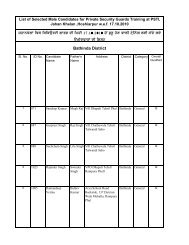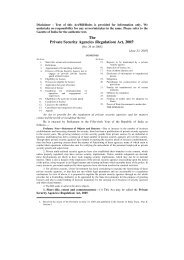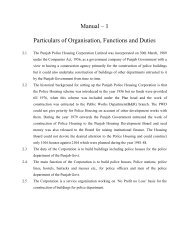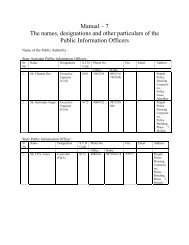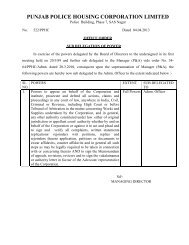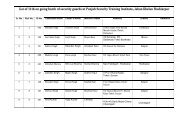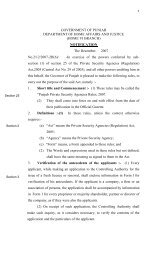Sr. No. ID No. Candidate Name Father's Name Mother's Name ...
Sr. No. ID No. Candidate Name Father's Name Mother's Name ...
Sr. No. ID No. Candidate Name Father's Name Mother's Name ...
- No tags were found...
Create successful ePaper yourself
Turn your PDF publications into a flip-book with our unique Google optimized e-Paper software.
(v)Ownership of multiple SIM cards: In the case of ‘pre-paid’ connections, multiple SIM cards are easy topurchase at a relatively low cost 25 , and the ownership of multiple SIMs enables users to switch nearlyinstantaneously between service providers to take advantage of current offers in price or other serviceoffers. The transferability of SIMs (allowing a single phone to be used with multiple prepaidsubscriptions) has been cited as an important reason for the popularity of prepaid use among lowerincome groups (Kalba, 2008) 26 . The use of mobile minutes among those with multiple SIM cards istherefore expected to be very sensitive to relative price changes. As expected, the number of SIMsowned by the non-zero PED group is found to be higher (1.70 compared to 1.20).C. Perceptions Toward Mobile Use & Attitude toward Mobile Service Provider:(i) Unwillingness to switch service providers: Respondents who indicate that they are unlikely to switch serviceproviders even if price were to fall have effectively disregarded outside options and are therefore likely tohave demand that is relatively inelastic to price change. The summary statistics indicate that the group withzero PED comprises a greater share of those who would not switch providers (39% against 33%).(ii) Perceived benefits: Those who perceive greater benefits from mobile use (whether social, economic oremergency related) are likely to use the mobile more if it were cheaper. In particular, however, those whoattach a greater importance to emergency-related benefits, which we interpret as greater contingency use ofthe mobile 27 , might be able to extend their range of existing uses to include social and economic purposes ifprice were to fall. As expected, the non-zero PED group has a significantly higher score for perceivedemergency benefits (92% versus 86%).D. ‘Telecom-connectedness’:This variable is captured by the number among ‘the top five individuals most frequently contacted by therespondent’ who own a phone. Users who are more ‘telecom-connected’ are more likely to take advantage of a25 Less than 3% of those who are unwilling to switch service providers cite financial constraints as their reason (see Table 10in the appendix). However, nearly 59% point to the ‘hassle of getting a new connection’ as the reason, suggesting that thereis an initial effort involved in acquiring the SIM card that is regarded as inconvenient.26 Other reasons cited for the multiple ownership of SIMs include “coverage differences, lack of interoperability (e.g., SMS),anonymity, expense tracking (e.g., personal vs. business use), roaming, functionality (data vs. voice), backup service, etc.”(Kalba, 2008)27 We find by a t test that those for whom the perceived emergency benefits is larger than the perceived social and economicbenefits are more modest users of the mobile (defined in terms of the value of the last top up in USD). This lends credenceto our hypothesis that a higher value place on emergency benefits can be interpreted as present contingency use andtherefore a greater likelihood of increased use if price were to fall: The average ‘last top-up value (in USD)’ for the groupplacing a higher value on emergency use is 1.14 USD against 1.32 USD for the rest (the t statistic is 2.74, p value 0.006).13




